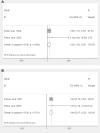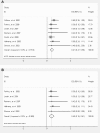Meta-analysis of the impact of human papillomavirus (HPV) on cancer risk and overall survival in head and neck squamous cell carcinomas (HNSCC)
- PMID: 20587061
- PMCID: PMC2908081
- DOI: 10.1186/1758-3284-2-15
Meta-analysis of the impact of human papillomavirus (HPV) on cancer risk and overall survival in head and neck squamous cell carcinomas (HNSCC)
Abstract
Background: HPV is important in a subset of HNSCC. Our meta-analysis determined the clinical characteristics of HPV-related HNSCC.
Method: Pubmed search terms "HPV" and "HNSCC" were used to identify 34 studies since 1980. We obtained pooled adjusted odds ratio (OR) or hazard ratio (HR) using random or fixed-effects model and compared OS depicted in forest plot.
Results: A total of 5681 patients were included. The prevalence of HPV+ tumors was 22%, with 86.7% of HPV16+ genotype. The OR for HNSCC in HPV16+ patients was 4.44 (95% CI = 2.87-6.02). HPV status was associated with p16 expression (adj OR = 3.00; 0.90-9.70), and HPV+ tumors were less likely to harbor p53 mutations (adj OR = 0.21; 0.04-0.38). The HR for death in HPV+ patients was 0.42 (0.27-0.57). HPV+ HNSCC also had a better response to therapy.
Conclusion: HPV+ HNSCC are established as a separate biologic entity. Prospective trials are needed to establish the optimal therapy for HPV+ HNSCC.
Figures


Similar articles
-
Prevalence of human papillomavirus types, viral load and physical status of HPV16 in head and neck squamous cell carcinoma from the South Swedish Health Care Region.J Gen Virol. 2016 Nov;97(11):2949-2956. doi: 10.1099/jgv.0.000611. Epub 2016 Sep 21. J Gen Virol. 2016. PMID: 27667722
-
Combined P16 and human papillomavirus testing predicts head and neck cancer survival.Int J Cancer. 2014 Nov 15;135(10):2404-12. doi: 10.1002/ijc.28876. Epub 2014 Apr 17. Int J Cancer. 2014. PMID: 24706381 Free PMC article.
-
Population-based evidence of increased survival in human papillomavirus-related head and neck cancer.Eur J Cancer. 2012 Jun;48(9):1341-6. doi: 10.1016/j.ejca.2012.03.014. Epub 2012 Apr 18. Eur J Cancer. 2012. PMID: 22516210
-
Epidemiology of human papillomavirus-related head and neck cancer.Otolaryngol Clin North Am. 2012 Aug;45(4):739-64. doi: 10.1016/j.otc.2012.04.003. Epub 2012 May 31. Otolaryngol Clin North Am. 2012. PMID: 22793850 Review.
-
The epidemiology and risk factors of head and neck cancer: a focus on human papillomavirus.J Dent Res. 2007 Feb;86(2):104-14. doi: 10.1177/154405910708600202. J Dent Res. 2007. PMID: 17251508 Review.
Cited by
-
Selective antitumor activity of roscovitine in head and neck cancer.Oncotarget. 2016 Jun 21;7(25):38598-38611. doi: 10.18632/oncotarget.9560. Oncotarget. 2016. PMID: 27233076 Free PMC article.
-
Immunological treatment options for locoregionally advanced head and neck squamous cell carcinoma.Int Rev Immunol. 2012 Feb;31(1):22-42. doi: 10.3109/08830185.2011.637253. Int Rev Immunol. 2012. PMID: 22251006 Free PMC article. Review.
-
Survival, recurrence and toxicity of HNSCC in comparison of a radiotherapy combination with cisplatin versus cetuximab: a meta-analysis.BMC Cancer. 2016 Aug 26;16(1):689. doi: 10.1186/s12885-016-2706-2. BMC Cancer. 2016. PMID: 27565887 Free PMC article.
-
Detailed Characteristics of Tonsillar Tumors with Extrachromosomal or Integrated Form of Human Papillomavirus.Viruses. 2019 Dec 30;12(1):42. doi: 10.3390/v12010042. Viruses. 2019. PMID: 31905862 Free PMC article.
-
Do We Have Enough Evidence to Specifically Recommend Transoral Robotic Surgery in HPV-Driven Oropharyngeal Cancer? A Systematic Review.Pathogens. 2023 Jan 18;12(2):160. doi: 10.3390/pathogens12020160. Pathogens. 2023. PMID: 36839432 Free PMC article. Review.
References
-
- Hammarstedt L, Lindquist D, Dahlstrand H, Romanitan M, Dahlgren LO, Joneberg J, Creson N, Lindholm J, Ye W, Dalianis T. Human papillomavirus as a risk factor for the increase in incidence of tonsillar cancer. International journal of cancer. 2006;119(11):2620–2623. doi: 10.1002/ijc.22177. - DOI - PubMed
Publication types
MeSH terms
LinkOut - more resources
Full Text Sources
Other Literature Sources
Medical
Research Materials
Miscellaneous

